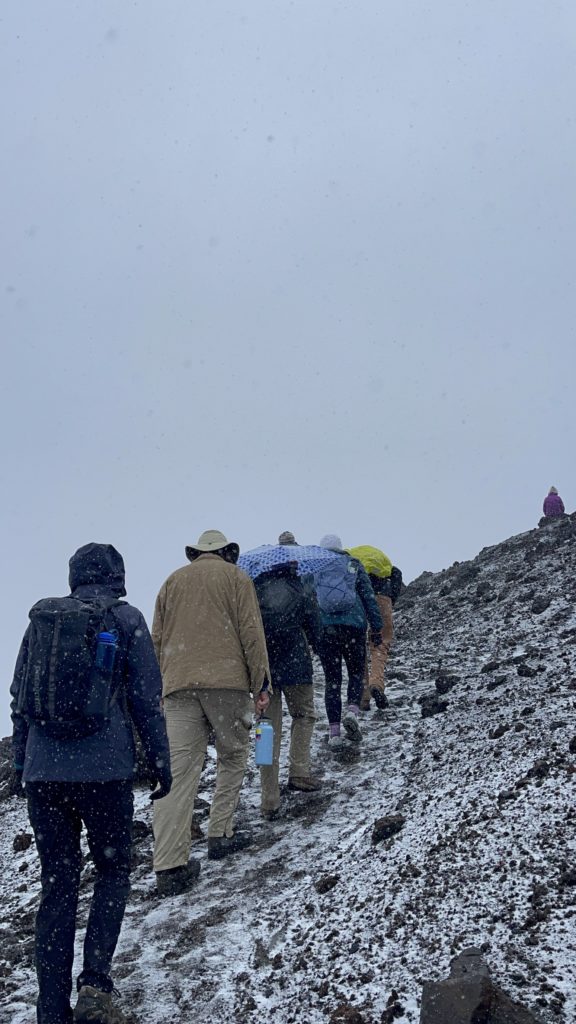Here we continue the behind-the-scenes tour of my recent mountain adventures! This post picks up where “Mountains and What They Are Made Of (part 1)” left off.
Cotopaxi
Even after three days in the Paramo, we apparently didn’t have our fill of outside adventures that week. So, we decided to visit Cotopaxi on Saturday.



We didn’t have much of a view because of the fog, but experiencing the mountain landscape, almost completely barren except for a few species of lichen, was incredible.
We knew that hiking Cotopaxi would be a challenge. Having been in Ecuador for two weeks, we were accustomed to the altitude. But, Cotopaxi was at another level. Literally. We didn’t summit, but we did hike up to the start of the glaciers, which were over 16,000 feet above sea level.
This was definitely a type-2 fun experience. That is, you’re glad you did it, but in the moment, you suffer. We all have varying levels of fitness and experience with altitude, so we felt it in different ways. Some people were just really tired and out of breath. For others, it was the hardest thing they had ever done in their life.
What I think was the most beautiful about this experience was how we supported each other. At one point, one member of our group was considering turning back. They needed to take a lot of breaks and worried they were holding everyone back. We told them, truthfully, that we didn’t care. We weren’t there to go fast, we were there to do it together.

It’s cool to say that I climbed halfway up a famous mountain. But, I feel more honored by the fact I got to share such a difficult experience with my cohort and be a part of supporting each other. That’s probably the real highlight.
Cloud Forest
Two days later, we were in a completely different ecosystem: the lush cloud forest on the western side of the Andes.

Ecuador has some of the most biodiverse ecosystems in the world, and you can really see that in the cloud forest. Here’s just a sampling:





Each day was a constant deluge of some of the most colorful and intricate birds, plants, and insects that you could imagine. Considering that we’re basically a big group of science nerds, there was no lack of enthusiasm for these discoveries. Lectures were frequently interrupted to pick up bugs, point our birds, and ask the scientific names of flowers.
Experiencing the wonder of all of these discoveries was certainly a highlight of the trip!
On our itinerary for Wednesday, we had a mysterious two-hour block that was simply labeled “drop off in forest.” Intriguing…

It turns out, it was exactly that. After completing our macroinvertebrate work examen, we were each dropped off in our own little corner of the forest. The idea was to experience what it’s like to be completely alone in nature.
You could imagine that this could be a pretty surreal experience. You’re all alone in the forest, with no sign of any human life, with only the sound of the birds and your thoughts for two hours.

In reality, it was nice, but not life-shattering. I was actually reminded of the many times I’ve done something similar at home, albeit not quite as isolated. Similarly, the flora and fauna of Michigan might not be as flashy, but in my experience, it has an equal ability to produce wonder.
This was a good reminder that much of what I have experienced here, at its core, is not limited to Ecuador. All of my “mountain top” moments — the excitement of anticipation, the joy of being a simple human, the bond of persevering together, the wonder of discovery, and the solitude of the natural world — are things that I can, and do, experience at home.
This is not to say that you shouldn’t study abroad if you have the opportunity. I would definitely recommend it. But, it is to say that it’s not the end-all-be-all.
There was actually a point last year where I considered not studying abroad. I had been reading the Sermon on the Mount where Jesus talks about not storing up treasures on earth, but instead treasures in Heaven. I realized then that I had been holding on tightly to the idea of studying abroad, thinking that I needed to “collect” all of the experiences in order to be fulfilled. I obviously did end up choosing to do a semester off-campus, but I had to first go through a period of time of letting that go, and realizing that I would actually be a-ok if I never had an abroad experience.
Now that I’m here, I feel like I’m more able to receive the experiences I get to have, while not being dependent on them. There are so many things I’m grateful to do, see, and learn here. But, none of it is necessarily any more valuable than my life at home.
Ecuador lesson #3: Mountains in Ecuador are made of the same dirt as forests in Michigan.
Or, in other words, you don’t have to travel to have what makes life great.
It’s just a bonus 
Hasta luego!
-Megan

The post Mountains and What They Are Made Of (part 2) appeared first on Off-Campus Study.
